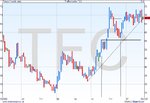This London stock, TFC, will do for another idea that I've thought of. Say that we are following the trendline and, provided the price remains above the line, we are satisfied with our profit margin for the time period (I position trade, if possible) A sudden jerk upwards to where my thicker horizontal line is will improve my position to about where I would expect to be in about four months time, represented by the 2 verticals. That was the first movement upwards, but if I had waited longer I would be even further ahead of schedule. I would think that was great! If one could get a feel of where one would expect the market to be that far ahead maybe, for instance, if it has had a good run already it may be ready for a fall, then that would help to make the decision of getting out and going somewhere else. Personally, if I had been that far ahead of my target trendline, I think I would have called it a day on a break below my higher horizontal line. It can be see that if I had not sold then I would on the trendline now, end of March, and would have wasted all that time since October.
Split
Split

